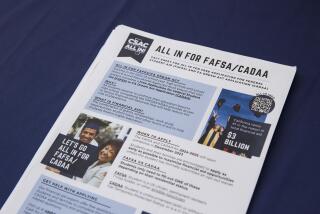A host of factors determine how much aid you can get
- Share via
Will your child qualify for financial aid at college? Most parents haven’t a clue.
That’s because families with seemingly similar incomes can meet vastly different fates in the financial aid sweepstakes.
“Two sets of parents with similar incomes will get very different financial aid packages, depending on the nature of their assets and the schools that their children apply to,” said Scott Anderson, president of College Financial Strategies in Davenport, Iowa.
The reason starts with the complicated federal formula that determines the so-called estimated family contribution. That’s what the federal government says the student and his or her family can pay for college.
This number is subtracted from the total cost of attendance to determine your need. However, quirks in the formula can make one family seem needy and another not -- even when they have nearly identical income and assets. The disparities are magnified by colleges, which have their own policies for the aid they provide.
Knowing how the system works can save parents with a child in college thousands of dollars a year, Anderson said. Here are the basics:
--
The federal formula
The first step in determining a child’s need involves filling out a lengthy financial statement called the Free Application for Federal Student Aid, which asks for the parents’ and student’s ages, income and assets and whether the family is supporting other students in college.
This information is plugged into a formula that determines how much the federal government says the student’s family can afford to pay toward each child’s college bills.
Private colleges require a second financial-aid application, called a profile. This form asks for information that’s not part of the government’s formula, including the amount of equity the family has in its home and the value of the parents’ retirement plan assets.
But the profile doesn’t necessarily result in less aid, said Kalman Chany, a New York-based college counselor and author of “Paying for College Without Going Broke.” Indeed, some college formulas are far more generous than the federal formula, he said.
--
Income
The federal formula weighs income most heavily. The student’s income, after a small allowance -- currently $2,600 -- is assessed at a 50% rate, meaning that half is expected to be used to pay educational expenses.
The parents’ income, after allowances for living expenses, taxes and a few other items, is assessed on a sliding scale. As income increases, so does the proportion, to as much as 47%, that is expected to be used.
--
Allowances
Not all income counts. But the allowances that reduce the amount of income that is assessed aren’t generous. The federal “income protection allowance” -- the amount the government figures you need to live on -- is currently $23,660 for a family of four. That amount is adjusted for inflation each year but is the same whether you live in Los Angeles, where the median home price is $580,000, or Laredo, Texas, where the median is $81,270.
Moreover, although parents get to subtract income and payroll taxes, there are limits to how much can be deducted. That disproportionately hurts families who live in high-tax cities and states, Chany said.
It’s worth noting that if the parents are divorced, the formula looks at the custodial parent’s finances. The other parent’s income could be much higher but is not assessed at all. But if the custodial parent remarries, the new spouse’s income is counted
--
Assets
The second big piece of the formula deals with assets held by the student and by his or her parents. Anticipating that all of a child’s assets will be used for college over four years, every dollar that the child has saved in his or her name reduces aid allowances by 35 cents each year. The most a parent will be expected to contribute from assets is 5.6 cents for each dollar of assets held.
--
Exclusions
Certain parental assets are exempted. For instance, your home equity and any money you have in retirement plans aren’t counted in the federal formula at all.
An additional portion of assets is excluded depending on the age of the older parent. The closer that parent is to retirement, the bigger the amount that is excluded.
Unfortunately, the financial aid forms are complex and the instructions can be misleading. As a result, many parents give up thousands of dollars of aid by filling them out incorrectly, listing assets that don’t have to be counted or double-counting assets that do, Chany said.
“A lot of families use much more of their assets than they need to,” he said.
--
Don’t give up
The biggest mistake parents make is accepting defeat, Anderson said.
For example, if you apply for aid one year but don’t get any, you might not bother to apply the next year when your second child enters college. But in fact your eligibility soars when you have two children in college.
Also, a school’s first offer of aid isn’t written in stone. If the family’s circumstances have changed because of a job loss, unusually large medical bills or some other economic reversal, the student can appeal the decision and possibly get more aid.
Moreover, students shouldn’t rule out expensive private colleges on financial grounds, both counselors said. Often those colleges are so much more generous with aid that they end up being less expensive in the end.
“Ignore the sticker price,” Chany said. “That’s probably not what you’re paying.”
--
More to Read
Sign up for Essential California
The most important California stories and recommendations in your inbox every morning.
You may occasionally receive promotional content from the Los Angeles Times.













